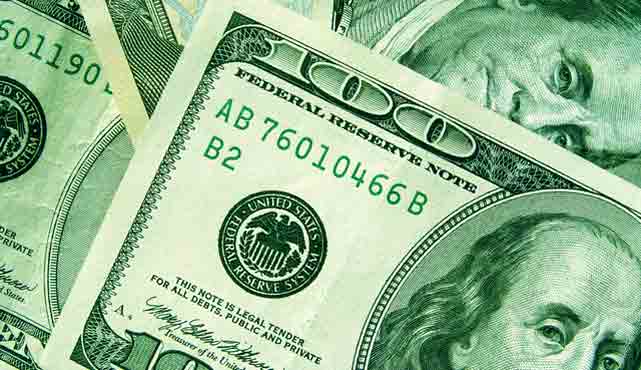Pound to Dollar Outlook: Markets Forecast 1.29 by End-2024 Amid Weaker USD
- Written by
Ben Hughes

MUFG forecasts that the Pound to Dollar (GBP/USD) exchange rate will strengthen to 1.30 at the end of 2024.
GBP/USD dipped to lows near 1.2600 before a recovery to just above 1.2700 and was resilient during the week.
Consensus forecasts are for GBP/USD to trade at 1.29 at the end of 2024 amid a weaker dollar.
Markets will be monitoring GBP/USD investment bank updates to see whether forecasts of losses in 2024 are revised.
US data releases were mixed and markets still priced in an early Federal Reserve rate cut while expectations of Bank of England rate cuts were scaled back slightly.
UK releases were relatively positive which triggered fresh expectations that the Bank of England would not be in a position to sanction a near-term cut in interest rates.
Overall risk appetite was relatively firm during the week.
According to ING; “In the past, sterling has had a decent correlation with the equity environment – which may explain how sterling survived the lower rate environment.”
UK data releases suggested a generally more optimistic picture over the economic outlook which helped supported the Pound.
As far as business confidence is concerned, there was a significant upward revision to the services-sector PMI index and the construction index recorded a slower rate of contraction.
The overall PMI, combining the construction, services and manufacturing data, increased to 51.7 in December from 50.2 in November, the highest reading since June.
Gabriella Dickens, senior UK economist at Pantheon Macroeconomics commented; "The further rebound in December's PMI suggests a recession should be narrowly avoided. The survey, however, adds weight to our view that activity should rise gradually over the course of 2024."
Mortgage approvals increased to a 5-month high just above 50,000 for November with a strong increase for consumer credit.
Halifax also reported a 1.1% increase in house prices for December after a 0.6% increase in November with the first annual increase since April 2023.
RSM economist Thomas Pugh, commented; “If house prices haven’t quite reached their lowest point, they’re probably not far off it. Indeed, now that attention has firmly turned to when interest rates will start to fall and mortgage rates have started to drop, the housing market is likely to stabilise.”
According to Jeremy Stretch, head of G10 FX Strategy at CIBC Capital Markets; "early BoE rate cut expectations (are) continuing to be pared. The large increase in monthly consumer credit, combined with an upgrade to final services PMI "provides a more constructive UK macro backdrop."
Following the data, markets are now pricing in around 120 basis points (bps) of cuts in 2024, compared to 140 bps expected on Thursday which helped underpin the Pound.
The monthly US employment report was stronger than expected with an increase in non-farm payrolls of 216,000 for December compared with consensus forecasts of 170,000, although the November increase was revised down to 173,000 from the 199,000 reported previously.
The household survey recorded no change in the unemployment rate from 3.7% compared with expectations of a small increase to 3.8%.
There was, however, a sharp drop in the participation rate and a huge decline in the number of employed people of close to 700,000.
The US ISM business confidence data for the services sector declined to a 7-month low of 50.6 from 52.7 previously and compared with expectations of 52.6 and there was a sharp drop in the employment component.
Following the ISM data, markets still priced in over a 65% chance of a rate cut at the March meeting while the chances of a May cut increased to over 90%.
According to ING; "Beyond the very short term, we still expect a further dollar decline to materialise this year as the deterioration in the economic outlook forces (a) large (amount of) Fed cuts."
Morgan Stanley has shifted its stance on the dollar; “Our conviction about dollar strength has waned meaningfully. US data deceleration has compressed growth differentials, US rates have fallen further compared with peers, and investors appear far from defensive based on equity returns."
There will be the threat of GBP/USD losses if Fed expectations are scaled back.
Matthew Ryan, head of market strategy at global financial services firm Ebury added; "We stand by our stance that calls for a first U.S. rate cut in March are premature, and that the Fed will need to see more evidence of a cooling in the jobs market, particularly in wages, to have confidence in achieving its medium-term inflation objective."
On a near-term view, Scotiabank sees the risk of GBP/USD losses; “Short-term charts look more range-bound but a step back to weekly chart shows a clearly bearish development via an “engulfing” line on the weekly candle. Short-term GBP support is 1.2615, with losses likely to accumulate below here.”
STORY LINK Pound to Dollar Outlook: Markets Forecast 1.29 by End-2024 Amid Weaker USD

MUFG forecasts that the Pound to Dollar (GBP/USD) exchange rate will strengthen to 1.30 at the end of 2024.
GBP/USD dipped to lows near 1.2600 before a recovery to just above 1.2700 and was resilient during the week.
Consensus forecasts are for GBP/USD to trade at 1.29 at the end of 2024 amid a weaker dollar.
Markets will be monitoring GBP/USD investment bank updates to see whether forecasts of losses in 2024 are revised.
US data releases were mixed and markets still priced in an early Federal Reserve rate cut while expectations of Bank of England rate cuts were scaled back slightly.
UK releases were relatively positive which triggered fresh expectations that the Bank of England would not be in a position to sanction a near-term cut in interest rates.
Overall risk appetite was relatively firm during the week.
Save on Your GBP/USD Transfer
Get better rates and lower fees on your next international money transfer. Compare TorFX with top UK banks in seconds and see how much you could save.
UK data releases suggested a generally more optimistic picture over the economic outlook which helped supported the Pound.
As far as business confidence is concerned, there was a significant upward revision to the services-sector PMI index and the construction index recorded a slower rate of contraction.
The overall PMI, combining the construction, services and manufacturing data, increased to 51.7 in December from 50.2 in November, the highest reading since June.
Gabriella Dickens, senior UK economist at Pantheon Macroeconomics commented; "The further rebound in December's PMI suggests a recession should be narrowly avoided. The survey, however, adds weight to our view that activity should rise gradually over the course of 2024."
Mortgage approvals increased to a 5-month high just above 50,000 for November with a strong increase for consumer credit.
Halifax also reported a 1.1% increase in house prices for December after a 0.6% increase in November with the first annual increase since April 2023.
RSM economist Thomas Pugh, commented; “If house prices haven’t quite reached their lowest point, they’re probably not far off it. Indeed, now that attention has firmly turned to when interest rates will start to fall and mortgage rates have started to drop, the housing market is likely to stabilise.”
According to Jeremy Stretch, head of G10 FX Strategy at CIBC Capital Markets; "early BoE rate cut expectations (are) continuing to be pared. The large increase in monthly consumer credit, combined with an upgrade to final services PMI "provides a more constructive UK macro backdrop."
Following the data, markets are now pricing in around 120 basis points (bps) of cuts in 2024, compared to 140 bps expected on Thursday which helped underpin the Pound.
The monthly US employment report was stronger than expected with an increase in non-farm payrolls of 216,000 for December compared with consensus forecasts of 170,000, although the November increase was revised down to 173,000 from the 199,000 reported previously.
The household survey recorded no change in the unemployment rate from 3.7% compared with expectations of a small increase to 3.8%.
There was, however, a sharp drop in the participation rate and a huge decline in the number of employed people of close to 700,000.
The US ISM business confidence data for the services sector declined to a 7-month low of 50.6 from 52.7 previously and compared with expectations of 52.6 and there was a sharp drop in the employment component.
Following the ISM data, markets still priced in over a 65% chance of a rate cut at the March meeting while the chances of a May cut increased to over 90%.
According to ING; "Beyond the very short term, we still expect a further dollar decline to materialise this year as the deterioration in the economic outlook forces (a) large (amount of) Fed cuts."
Morgan Stanley has shifted its stance on the dollar; “Our conviction about dollar strength has waned meaningfully. US data deceleration has compressed growth differentials, US rates have fallen further compared with peers, and investors appear far from defensive based on equity returns."
There will be the threat of GBP/USD losses if Fed expectations are scaled back.
Matthew Ryan, head of market strategy at global financial services firm Ebury added; "We stand by our stance that calls for a first U.S. rate cut in March are premature, and that the Fed will need to see more evidence of a cooling in the jobs market, particularly in wages, to have confidence in achieving its medium-term inflation objective."
On a near-term view, Scotiabank sees the risk of GBP/USD losses; “Short-term charts look more range-bound but a step back to weekly chart shows a clearly bearish development via an “engulfing” line on the weekly candle. Short-term GBP support is 1.2615, with losses likely to accumulate below here.”
International Money Transfer? Ask our resident FX expert a money transfer question or try John's new, free, no-obligation personal service! ,where he helps every step of the way, ensuring you get the best exchange rates on your currency requirements.
TAGS: Pound Dollar Forecasts
Comments are currrently disabled
Related Stories:
- GBP/USD Forecast: Pound Sterling Firm as CPI Leaves Fed Bets Intact - January 13, 2026
- Pound-to-Dollar Forecast: Powell Legal Row Undermines USD Support - January 13, 2026
- Pound Sterling to Dollar Forecast: GBP Rebounds above $1.34 on USD Shock - January 12, 2026
- Pound to Dollar Week Ahead Forecast: GBP/USD Vulnerable - January 12, 2026
- Pound-to-Dollar Forecast: GBP/USD Risks Sustained Decline Below 1.34 - January 11, 2026
- Pound-to-Dollar Forecast: US Claims Data Supports USD Pressuring GBP - January 9, 2026
- GBP/USD Forecast: Pound Sterling Remains "Neutral" as Nov Rally Stalls - January 9, 2026
- Pound Sterling to Dollar Forecast: Can GBP Break Higher as USD Backing Fades? - January 8, 2026
- GBP/USD Forecast: Pound Sterling Capped below $1.35 on Services PMI - January 8, 2026
Latest News:
- GBP/USD Forecast: Pound Sterling Firm as CPI Leaves Fed Bets Intact - January 13, 2026
- Pound to Euro Holds Near €1.15 - January 13, 2026
- British Pound to Euro Forecast: GBP Holds Ground Against EUR Amid Global Uncertainty - January 13, 2026
- Pound-to-Dollar Forecast: Powell Legal Row Undermines USD Support - January 13, 2026
- Pound to Euro Holds Near €1.15 as Dollar Slumps - January 12, 2026
- Pound Sterling to Dollar Forecast: GBP Rebounds above $1.34 on USD Shock - January 12, 2026
- Pound to Dollar Week Ahead Forecast: GBP/USD Vulnerable - January 12, 2026
- Euro-to-Dollar Forecast: EUR/USD Pressured as Markets Reassess Fed Cuts - January 12, 2026
- Pound-to-Euro Week Ahead Forecast: UK Growth Critical for GBP/EUR in 2026 - January 12, 2026
- Pound-to-Dollar Forecast: GBP/USD Risks Sustained Decline Below 1.34 - January 11, 2026









